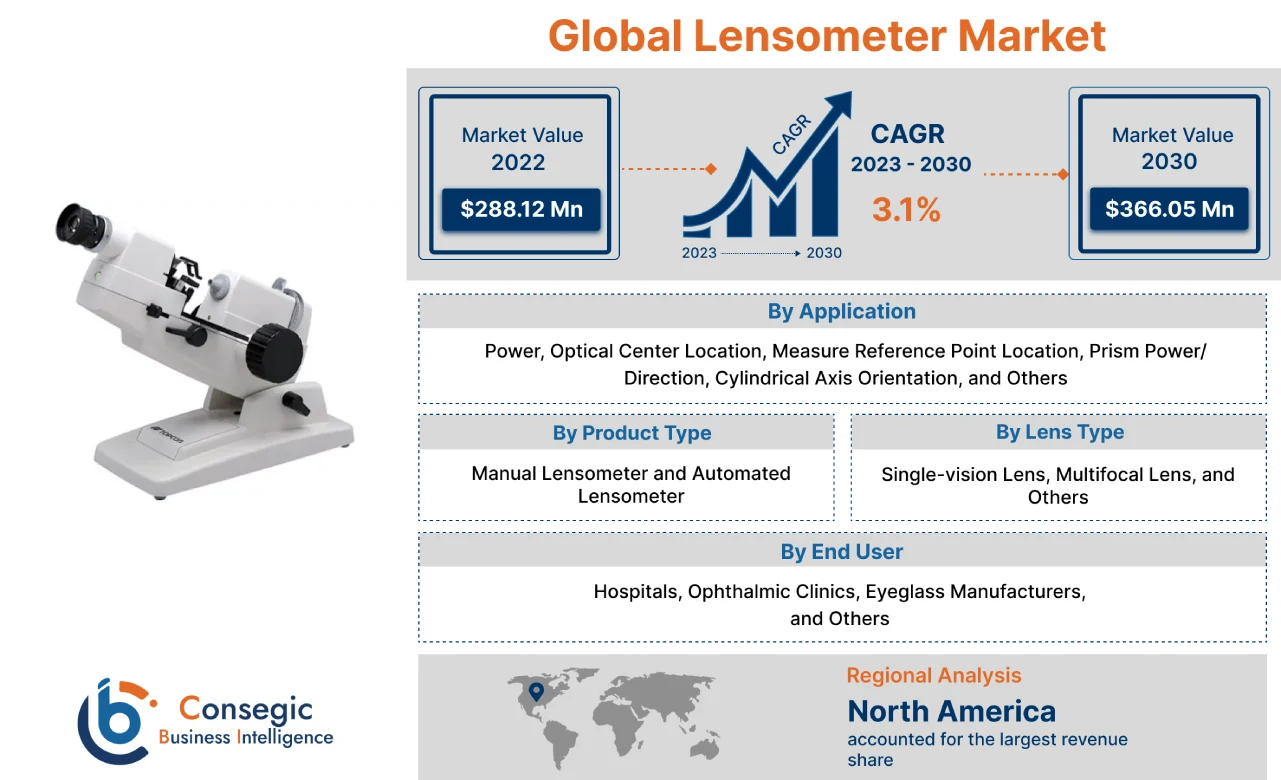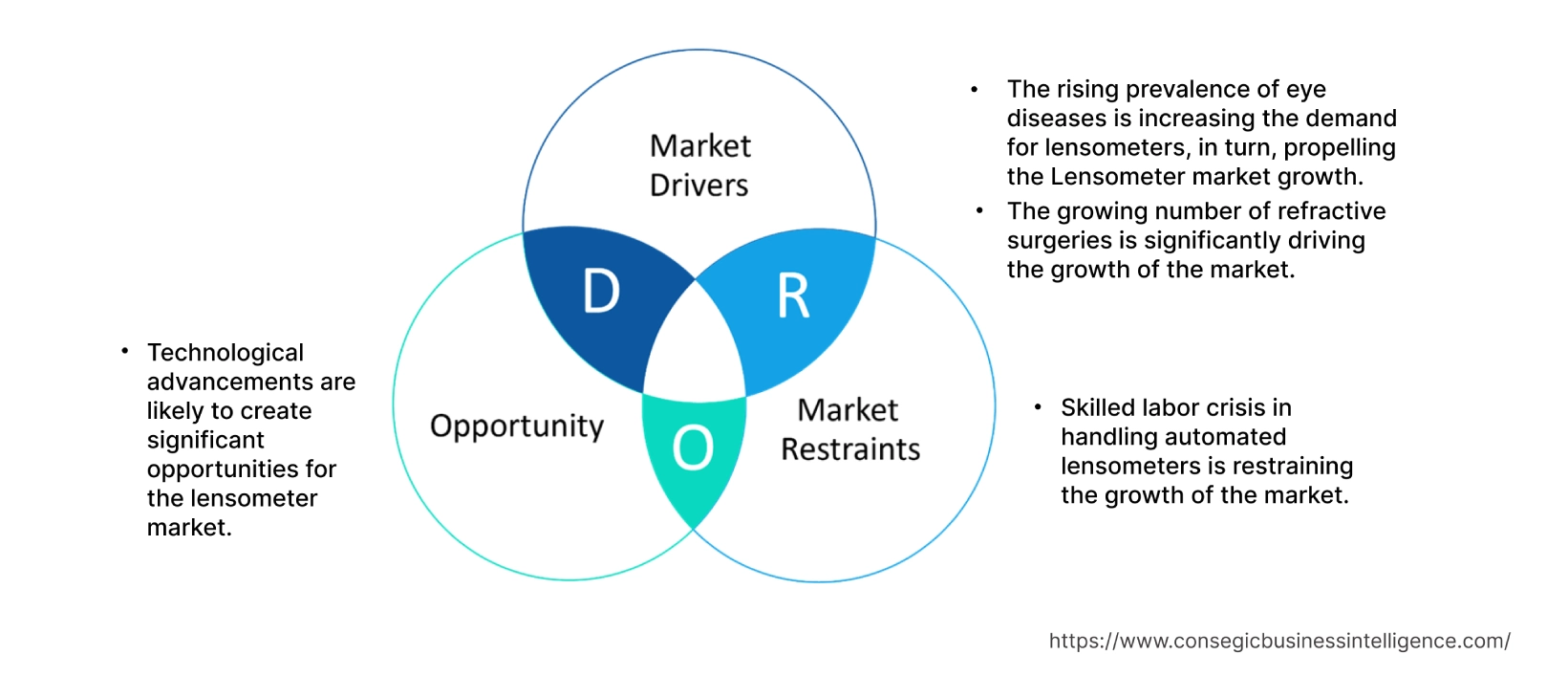Lensometer Market Size :
Consegic Business Intelligence analyzes that the Lensometer Market size is growing with a CAGR of 3.1% during the forecast period (2023-2030), and the market is projected to be valued at 366.05 Million by 2030 from 288.12 Million in 2022.
Lensometer Market Scope & Overview:
A Lensometer, also known as a lensmeter or focimeter. It is an optical instrument used to measure the power and other characteristics of the lenses. It is commonly used in optometry and ophthalmology practices to determine the prescriptions of eyeglasses or contact lenses. The lensometer measures the refractive power of lenses, including spherical, cylindrical, and prism powers as well as the axis of astigmatism. It also measures the pupillary distance, optical center, and other parameters necessary for the accurate fitting of the corrective lenses. Lensometer are used in wide applications scope namely Power, Optical Center Location, Measure Reference Point Location, Prism Power/Direction, Cylindrical Axis Orientation, and Others.
Lensometer Market Insights :
Lensometer Market Dynamics - (DRO) :
Key Drivers :
The rising prevalence of eye diseases is increasing the demand for lensometers, in turn, propelling the Lensometer market growth
Lensometers play a crucial role in ensuring the accuracy of prescription lenses leading to clear vision and enhance eye comfort for an individual who wears glasses or lenses. The rising prevalence of vision disorders such as blindness, myopia, and vision impairments is driving the demand for accurate and efficient diagnostics tools like lensometers. For instance, in 2023, according to the World Health Organisation (WHO), it is estimated that globally, at least 2.2 billion people have a near or distant impairment. That means globally 36% of people with a distance vision impairment due to refractive error and about 17% of people have vision impairment. Hence the growing prevalence of eye diseases is improving the demand for lensometers for the manufacturing of eyeglasses and lenses, which is driving the growth of the lensometer market.
The growing number of refractive surgeries is significantly driving the growth of the market
Refractive surgery is an eye surgery used to improve the refractive state of the eye. Powered eyeglasses and lenses are normally prescribed for the person after this refractive surgery. Lensometer is used to measure the prescription of glasses in ophthalmology and optometry, enabling the correct prescription to improve vision. Refractive surgery is widely performed to correct the spectacle power (refractive error) of the eye. It is ideally done to get rid of or reduce dependence on glasses and contact lenses. For instance, according to the report by the National Institute of Health in December 2020, the global demand for refractive surgery is expected to grow at a compound annual rate of 4% from 2019 to 2024, with annual surgical volume increasing from 4.7 million to 5.7 million procedures. Furthermore, LASIK surgeons use this sophisticated, computerized technology to measure the eye's aberrations accurately including a lensometer. These surgeries help the person or patient to get better and more precise vision. Thus, the use of lensometers in refractive surgeries such as LASIK and others is driving the demand for lensometers in the market.
Key Restraints :
Skilled labor crisis in handling automated lensometers is restraining the growth of the market
Manual lensometers are easy to operate and cost-effective, and the involvement of automated lensometers significantly increasing across the globe owing to the high precision of the product. Owing to this, the need for technicians with specialized expertise in operating and maintaining these sophisticated instruments is growing. Operating a lensometer requires specific knowledge and skills. The intricate calibration, maintenance, and troubleshooting requirements of automated lensometers demand a workforce skilled in optics, electronics, and software integration. The shortage of qualified and skilled optometrists or technicians proficient in using and maintaining automated lensometers is negatively affecting the integration of automated lensometers across the globe, which is acting as a restraint for the overall market growth.
Future Opportunities :
Technological advancements are likely to create significant opportunities for the lensometer market
Continuous technological advancements in lensometers such as improved accuracy, automation features, and integration with electronic health record (HER) systems, present opportunities for manufacturers to develop innovative and user-friendly lensometers. These advancements can enhance the efficiency and accuracy of lens measurement, leading to improved patient outcomes. For instance, in March 2022, Topcon Healthcare, a leading provider of medical devices and software solutions, has SOLOS, an automated lens analyzer that enables accurate, and efficient, advanced lens analysis. SOLOS helps to streamline clinical workflow by combining a fully automated lensometer with a full-range spectrometer. Hence, the overall integration of advanced technologies in lensometer is likely to shape the industry, making it more competitive and responsive to evolving consumer needs.
Lensometer Market Report Insights :
| Report Attributes | Report Details |
| Study Timeline | 2017-2030 |
| Market Size in 2030 | USD 366.05 Million |
| CAGR (2023-2030) | 3.1% |
| By Product Type | Manual Lensometer and Automated Lensometer |
| By Lens Type | Single-vision Lens, Multifocal Lens, and Others |
| By Application | Power, Optical Center Location, Measure Reference Point Location, Prism Power/Direction, Cylindrical Axis Orientation, and Others |
| By End User | Hospitals, Ophthalmic Clinics, Eyeglass Manufacturers, and Others |
| By Region | North America, Europe, Asia-Pacific, Latin America, and Middle East & Africa |
| Key Players | Topcon Corporation, Essilor, Coburn Technologies, Inc., NIDEK CO., LTD., Takagi Seiko Co., Ltd, Reichert, Inc., Visionx, NINGBO FLO OPTICAL CO., LTD., ZEISS Group, and TomeyUSA |
Lensometer Market Segmental Analysis :
By Product Type :
The Product type segment is categorized into manual lensometer and automated lensometer. In 2022, the manual lensometer segment accounted for the highest market share in the overall lensometer market. Manual lensometers are the traditional lensometers requiring manual adjustment and measurement. They are typically less expensive compared to automated lensometers and they are commonly used in small optometry practices and clinics. Further, manual lensometers are designed to be used in laboratory or high-volume environments. Its adjustable position angle is easily operated, and the device is also able to measure contact lens power. Hence the high affordability, easy application, and high durability are the factors driving the segment growth.
However, the automated segment is expected to grow at the fastest CAGR in the market during the forecast period. The growth of the segment is attributed to the high efficiency, accuracy, and convenience in measuring eyeglasses prescriptions. Additionally, automated lensometers ensure precise prescriptions by avoiding human errors. Such factors will foster market growth over the forecast period.
By Lens Type :
The lens type segment is categorized into single-vision lens, multifocal lens, and others. In 2022, the single-vision lens segment accounted for the highest market share of 41.02% in the overall lensometer market. Single-vision lenses have a single focal point and are used to correct either nearsightedness (Myopia) or farsightedness (hyperopia) and have consistent prescription power throughout the entire lens. The increasing cases of myopia are driving segment growth globally. For instance, as per the International Myopia Institute, a report estimated that on average 30% of the population is suffering from myopia, and it is estimated to grow to almost 50% by 2025. Hence, the aforementioned factors are leading to an increased demand for lensometers in eye diseases such as myopia, hyperopia, and others, in turn, propelling the market growth in the following years.
However, the multifocal lens segment is expected to grow at the fastest CAGR in the market during the forecast period. The demand for multifocal lenses is growing due to their benefits such as correcting presbyopia and astigmatism.
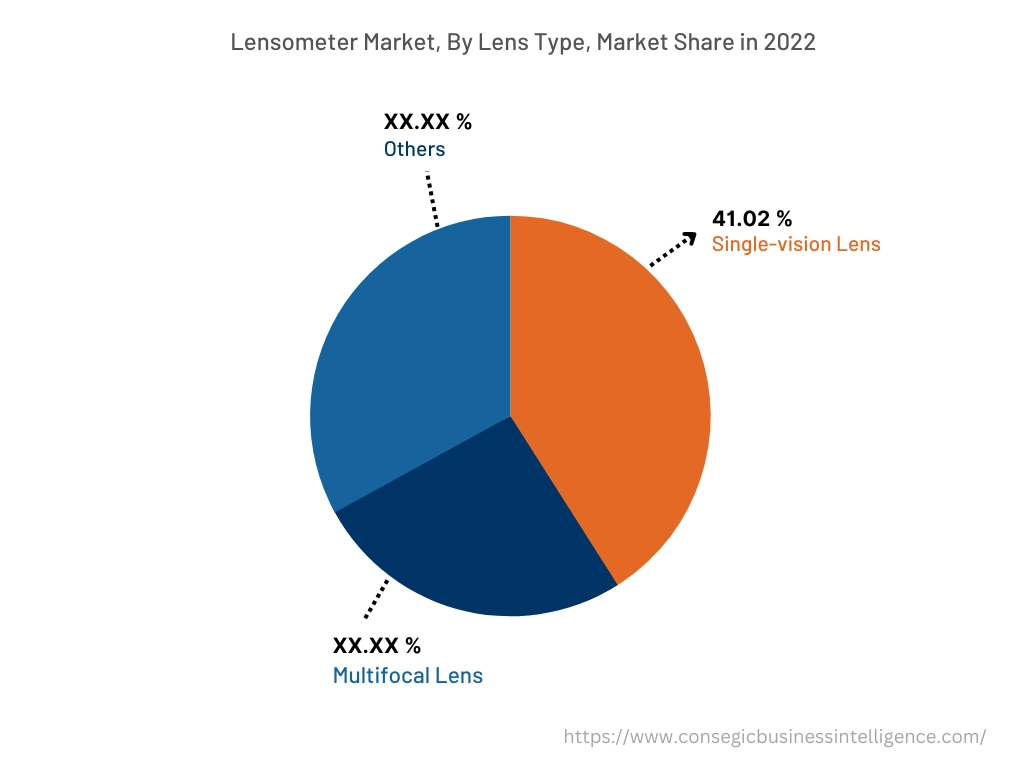
By Application :
The Application segment is categorized into power, optical center location, measure reference point location, prism power/direction, cylindrical axis orientation, and others. In 2022, the power segment accounted for the highest market share in the overall Lensometer market and is also expected to grow at the fastest CAGR in the market during the forecast period. The new glasses should be measured with a lensometer to confirm that the prescription is correct. The lensometer helps orient appropriately and mark uncut lenses, verifying the power of single vision, bifocal, and trifocal lenses, and checking the right mounting of eye lenses in spectacle frames. Whereas the digital lensometer uses green LED light capture techniques and auto lens detection techniques for determining the accurate power.
By End-User :
The end user segment is categorized into hospitals, ophthalmic clinics, eyeglass manufacturers, and others. In 2022, the ophthalmic clinics segment accounted for the highest market share in the overall lensometer market. Lensometer is commonly used by optometrists in ophthalmic clinics. These practices use lensometers for accurate prescription measurement and to ensure the correct fitting of eyeglasses and contact lenses for their patients. This has led to the wide acceptance of lensometers in the ophthalmic diagnostic industry. Hence, the above-mentioned factors are driving the significant growth of the segment in the lensometer market.
However, the eyeglass manufacturer segment is expected to grow at the fastest CAGR in the market during the forecast period. The growth of the segment is attributed to the increasing awareness among people regarding the harmful effects of ultraviolet rays. Such factors will foster market growth over the forecast period.
By Region :
The regional segment includes North America, Europe, Asia Pacific, Middle East and Africa, and Latin America.
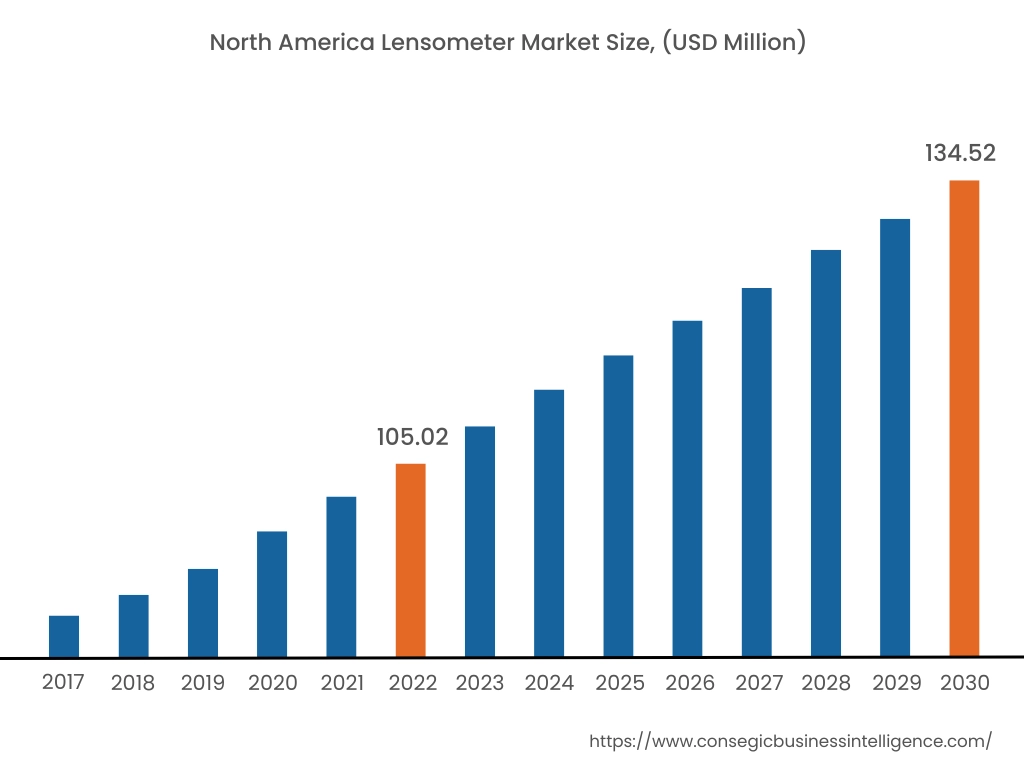
In 2022, North America accounted for the highest market share of 36.45% and was valued at USD 105.02 million and is expected to reach USD 134.52 million in 2030. Owing to the high prevalence of visual impairments and well-established healthcare infrastructure. In the North America region, the U.S. accounted for the highest market share of 66.50% during the base year 2022, owing to the rising geriatric population, rising demand for eyeglasses, increasing eye problems, and increasing eye surgeries in the region. According to a report by the Center for Disease Control and Prevention in December 2022, approximately 12 million people 40 years and in the U.S. are diagnosed with vision impairment. This high number of vision impairment patients are improving the demand for lensometer for the manufacturing of contact lenses and eyeglasses, which in turn, drives the lensometer market growth in the region.
Moreover, Asia Pacific is expected to grow at the fastest CAGR of 3.8% during the forecast period due to the high prevalence of ocular diseases across the region. For instance, according to the report by the National Institute of Health in September 2021, South Asia has the highest age-standardized prevalence of moderate to severe visual impairment at 17.5% and mild vision impairment at 12.2% globally.
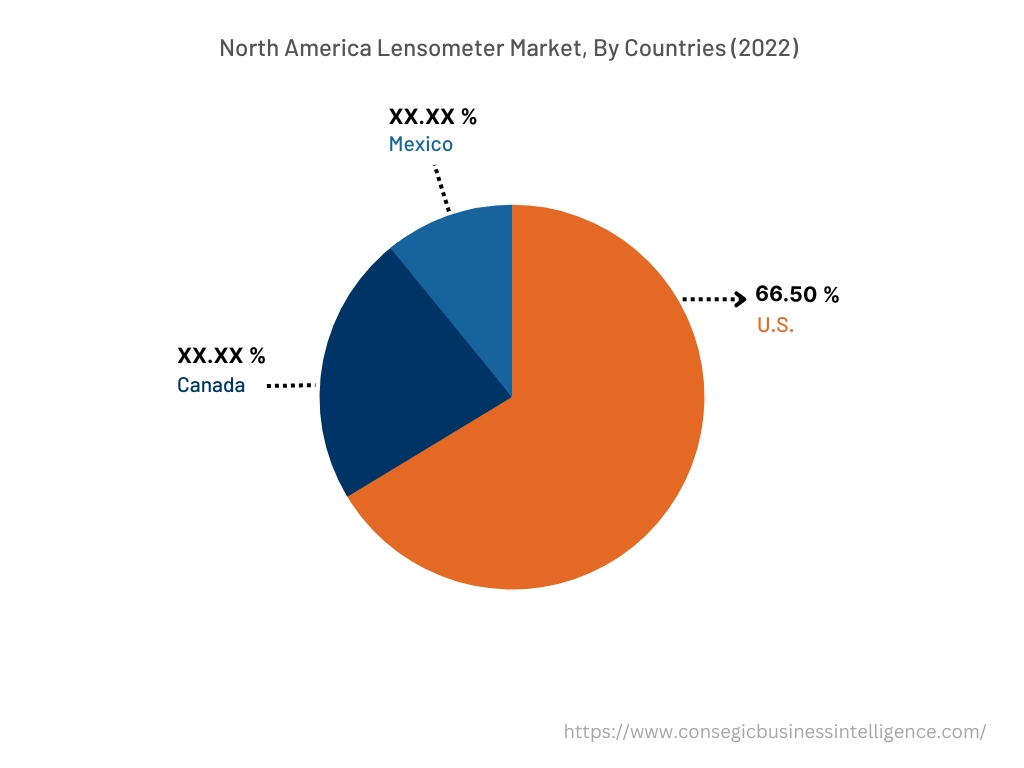
Top Key Players & Market Share Insights:
The Lensometer Market is highly competitive, with several large players and numerous small and medium-sized enterprises. These companies have strong research and development capabilities and a strong presence in the market through their extensive product portfolios and distribution networks. The market is characterized by intense competition, with companies focusing on expanding their product offerings and increasing their market share through mergers, acquisitions, and partnerships. The key players in the market include-
- Topcon Corporation
- Essilor
- NINGBO FLO OPTICAL CO., LTD.
- ZEISS Group
- TomeyUSA
- Coburn Technologies, Inc.
- NIDEK CO., LTD.
- Takagi Seiko Co., Ltd
- Reichert, Inc.
- Visionx
Recent Industry Developments :
- In March 2022, Topcon Healthcare, a leading provider of medical devices and software solutions, has SOLOS, an automated lens analyzer that enables accurate, and efficient, advanced lens analysis.
Key Questions Answered in the Report
What was the market size of the lensometer market in 2022? +
In 2022, the market size of lensometer was USD 288.12 million
What will be the potential market valuation for the lensometer market by 2030? +
In 2030, the market size of lensometer will be expected to reach USD 366.05 million.
What are the key factors driving the growth of the Lensometer market? +
The increasing prevalence of eye diseases is the key factor driving the growth of the lensometer market.
What is the dominating segment in the Lensometer market by lens type? +
In 2022, the single-vision lens segment accounted for the highest market share of 41.02% in the overall Lensometer market.
Based on current market trends and future predictions, which geographical region will have the fastest impact on the lensometer market's growth in the coming years? +
Asia Pacific is expected to be the fastest-growing region in the market during the forecast period.
